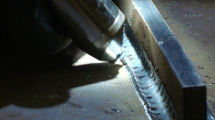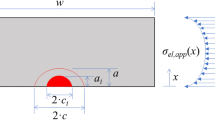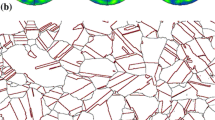Abstract
In this article, the results of a recent study aimed at evaluating, understanding, and rationalizing the extrinsic influence of fatigue loading on the response characteristics of built-up welded beams made from commercially pure titanium (Grade 2) are presented and discussed. The beams were made from welding plates and sheets of titanium using the pulsed gas metal arc welding technique to form a structural beam having an I-shaped cross section. The welds made for the test beams of the chosen metal were fillet welds using a matching titanium filler metal wire. The maximum and minimum load values at which the built-up beams were cyclically deformed were chosen to be within the range of 22-45% of the maximum predicted flexural static load. The beams were deformed in fatigue at a stress ratio of 0.1 and constant frequency of 5 Hz. The influence of the ratio of maximum load with respect to the ultimate failure load on fatigue performance, quantified in terms of fatigue life, was examined. The percentage of maximum load to ultimate load that resulted in run-out of one million cycles was established. The overall fracture behavior of the failed beam sample was characterized by scanning electron microscopy observations to establish the conjoint influence of load severity, intrinsic microstructural effects, and intrinsic fracture surface features in governing failure by fracture.









Similar content being viewed by others
References
A.K. Patnaik, C. Menzemer, and T.S. Srivatsan, On the Use of Titanium Alloys for Aerospace and Non-Aerospace Applications, Processing and Fabrication of Advanced Materials, PFAM XVII, N. Batnagar and T.S. Srivatsan, Ed., December 3-22, 2008
M. Peters, J. Kumpfert, C.H. Ward, and C. Leyens, Titanium Alloys for Aerospace Applications, Adv. Eng. Mater., 2003, 5(6), p 419–427
C. Leyens and M. Peters, Ed., Titanium and Titanium Alloys—Fundamental and Applications, Wiley-VCH, 2003
V.N. Moiseyev, Structural Titanium Alloys in Modern Mechanical Engineering, Met. Sci. Heat Treat., 2004, 46(3–4), p 115–120
A.K. Patnaik, N. Poondla, U. Bathini, and T.S. Srivatsan, An Overview of Large Structures Fabricated from Titanium and Titanium Alloys, Processing and Fabrication of Advanced Materials, PFAM-XVIII, Vol 2, M. Niimoni, M. Morinaga, M. Nakai, N. Bhatnagar, and T.S. Srivatsan, Ed., Japan, 2009, p 831–848
A. Patnaik, T.S. Srivatsan, N. Poondla, and U. Bathini, A Study Aimed at Evaluating, Understanding, Rationalizing the Strength, Endurance and Performance of Structures Made from Titanium and Titanium Alloy, Final Technical Report, Defense Metals Technology Center (Canton, OH, USA) and Universal Technology Resources Services, Inc (Cherry Hill, NJ, USA), October 2009
A.K. Patnaik, N. Poondla, U. Bathini, T.S. Srivatsan, and T. Quick, Investigating and Understanding the Fatigue Response and Failure of Built-Up Welded Beams of a Titanium Alloy, Fatigue of Materials: Advances and Emergence in Understanding Materials Science and Technology (MS&T 10), Houston, TX, October 2010, p 195–216
S. Luckowski, Titanium—Protecting the Soldiers of Operation Iraqi Freedom, Titanium 2005—21st Annual Conference Proceedings, International Titanium Association, 2005
S. Luckowski and J. Schutz, New Titanium Armor Application Provides Protection in a Lightweight Kit, Titanium 2008—24th Annual Conference Proceedings, International Titanium Association, 2008
S. Luckowski, Applications of Titanium in Armor Solutions, Titanium 2006—22nd Annual Conference Proceedings, International Titanium Association, 2006
AWS D1.9/D1.9 M, Structural Welding Code—Titanium, The American Welding Society, July 2007
A.K. Patnaik, N. Poondla, U. Bathini, and T.S. Srivatsan, On the Use of Gas Metal Arc Welding for Manufacture of Beams of Commercially Pure Titanium and a Titanium Alloy, Mater. Manuf. Process., 2011, 20 (in press)
Acknowledgments
This article is based on a research study that was funded by the US Army Picatinny Arsenal through the Defense Metals Technology Center [DMTC], North Canton, OH, USA. The authors gratefully acknowledge the support of Mr. Michael Trzcinski and Mr. Charles Clark of the DMTC, and Mr. Stephen Luckowski of the US Army (Picatinny Arsenal, NJ, USA). Sincere thanks and appreciation are extended to the anonymous reviewer for his/her many useful, important, and relevant comments and suggestions, which have helped strengthen this technical article.
Author information
Authors and Affiliations
Corresponding author
Additional information
The views and conclusions contained in this article are those of the authors and should not be interpreted as representing the official policies, either expressed or implied, of the US Army or the United States government. The US government is authorized to reproduce and distribute reprints of this article for government purposes notwithstanding any copyright notation hereon.
Rights and permissions
About this article
Cite this article
Patnaik, A., Poondla, N., Bathini, U. et al. The Fatigue Behavior of Built-Up Welded Beams of Commercially Pure Titanium. J. of Materi Eng and Perform 20, 1247–1255 (2011). https://doi.org/10.1007/s11665-010-9773-3
Received:
Revised:
Published:
Issue Date:
DOI: https://doi.org/10.1007/s11665-010-9773-3




